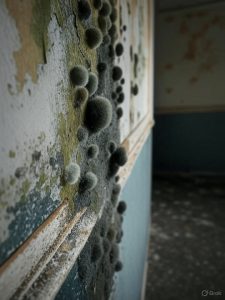
Note: This post was created (with help from Grok AI) to give you the introduction to CIRS. In the next one I’ll show you how we treat it with homeopathy.
Understanding Chronic Inflammatory Response Syndrome (CIRS): Causes and Potential Treatments
Chronic Inflammatory Response Syndrome (CIRS) is a complex, multi-system condition triggered by exposure to biotoxins, often leading to persistent inflammation and a range of debilitating symptoms. Below, we explore what CIRS is, its causes, and potential treatments to help manage this challenging condition.
What is Chronic Inflammatory Response Syndrome (CIRS)?
CIRS is a chronic illness characterized by an overactive immune response to biotoxins, such as those produced by mold, bacteria, or other environmental triggers. It was first described by Dr. Ritchie Shoemaker, who identified it in patients exposed to water-damaged buildings. Unlike typical immune responses, CIRS occurs when the body fails to clear biotoxins, leading to ongoing inflammation that affects multiple systems, including the brain, lungs, gut, and endocrine system.
Symptoms of CIRS are diverse and can include:
-
Fatigue and weakness
-
Cognitive difficulties (“brain fog”)
-
Chronic pain, muscle aches, or joint pain
-
Respiratory issues, such as shortness of breath
-
Digestive problems
-
Sensitivity to light, sound, or chemicals
-
Mood disturbances, including anxiety or depression
Due to its wide-ranging symptoms, CIRS is often misdiagnosed as fibromyalgia, chronic fatigue syndrome, or other conditions.
Causes of CIRS
CIRS is primarily triggered by exposure to biotoxins, which are toxic substances produced by certain microorganisms. Common causes include:
-
Mold and Water-Damaged Buildings:
The most frequent trigger for CIRS is exposure to mold in water-damaged environments. Buildings with poor ventilation, leaks, or flooding can harbor molds like Aspergillus, Penicillium, or Stachybotrys (black mold), which release biotoxins. Inhalation of these toxins can initiate CIRS in susceptible individuals.
-
Lyme Disease and Tick-Borne Infections:
Biotoxins from bacteria like Borrelia burgdorferi (the cause of Lyme disease) or co-infections can trigger CIRS, especially in cases of chronic or untreated Lyme disease.
-
Other Biotoxin Exposures:
Less common sources include exposure to cyanobacteria (blue-green algae), certain dinoflagellates (e.g., in red tide events), or other environmental toxins like actinomycetes.
-
Genetic Predisposition:
Research suggests that 24% of the population has a genetic predisposition (HLA-DR gene variants) that impairs their ability to clear biotoxins. In these individuals, biotoxins persist in the body, triggering an ongoing inflammatory response.
-
Environmental Factors:
Poor indoor air quality, chemical exposures, or chronic infections can exacerbate CIRS by overwhelming the body’s detoxification pathways.
How CIRS Develops
In individuals with CIRS, the immune system fails to recognize and eliminate biotoxins effectively. This leads to a cascade of inflammatory responses, including the release of cytokines, complement proteins, and other immune mediators. Over time, this chronic inflammation disrupts hormonal balance, mitochondrial function, and neurological health, contributing to the wide array of symptoms.
Diagnosis of CIRS
Diagnosing CIRS can be challenging due to its overlap with other conditions. Dr. Shoemaker developed a diagnostic protocol that includes:
-
Exposure History: Documenting exposure to water-damaged buildings, tick bites, or other biotoxin sources.
-
Symptom Clusters: Assessing symptoms across multiple systems (e.g., neurological, respiratory, musculoskeletal).
-
Biomarker Testing: Blood tests to measure markers like C4a, TGF-beta1, VEGF, and MSH (melanocyte-stimulating hormone) can indicate CIRS.
-
Visual Contrast Sensitivity (VCS) Test: A non-invasive test to assess neurological dysfunction caused by biotoxin exposure.
-
Genetic Testing: Identifying HLA-DR gene variants to confirm susceptibility.
Treatment Options for CIRS
Treating CIRS requires a multi-faceted approach aimed at removing biotoxin exposure, supporting detoxification, and reducing inflammation. Below are some commonly used treatments, though they should be tailored to the individual under medical supervision:
-
Remove Exposure:
The first and most critical step is to eliminate ongoing exposure to biotoxins. This may involve:
-
Remediating mold in the home or workplace.
-
Using air purifiers with HEPA filters.
-
Relocating to a safer environment if necessary.
-
Binders to Remove Biotoxins:
Medications like cholestyramine or welchol are often prescribed to bind biotoxins in the gut, preventing their reabsorption. These binders help the body excrete toxins more effectively.
-
Anti-Inflammatory Therapies:
-
Diet: An anti-inflammatory diet, such as a low-mold or gluten-free diet, can reduce symptom severity. Avoiding processed foods, sugar, and potential allergens is key.
-
Supplements: Omega-3 fatty acids, curcumin, and antioxidants like glutathione may help reduce inflammation and support detoxification.
-
Low-Dose Naltrexone (LDN): Some practitioners use LDN to modulate the immune system and reduce inflammation.
-
Address Hormonal Imbalances:
CIRS often disrupts hormones like cortisol, ACTH, or ADH. Hormone replacement or supplementation may be necessary under medical guidance.
-
Treat Co-Infections:
If Lyme disease or other infections are present, targeted antimicrobial therapy may be needed to address underlying infections.
-
Support Detoxification Pathways:
-
Cognitive and Neurological Support:
Neurofeedback, cognitive therapy, or medications to address brain fog and neurological symptoms may be beneficial.
-
Lifestyle Modifications:
Stress management, adequate sleep, and gentle exercise (as tolerated) can support overall recovery.
Challenges and Considerations
CIRS treatment is highly individualized, and not all patients respond to the same therapies. Working with a healthcare provider experienced in CIRS, such as a functional medicine doctor or a Shoemaker-certified practitioner, is crucial. Additionally, the financial and emotional burden of remediating environments and pursuing treatment can be significant, so support systems are essential.
Conclusion
Chronic Inflammatory Response Syndrome is a debilitating condition triggered by biotoxin exposure and perpetuated by immune dysregulation. While it can be challenging to diagnose and treat, a comprehensive approach that includes removing exposure, supporting detoxification, and reducing inflammation can lead to significant improvements. If you suspect CIRS, consult a knowledgeable healthcare provider to develop a personalized treatment plan. With the right strategies, many individuals with CIRS can regain their health and quality of life.

